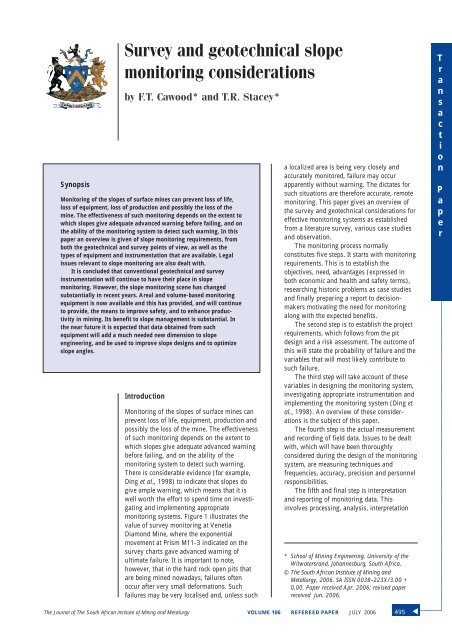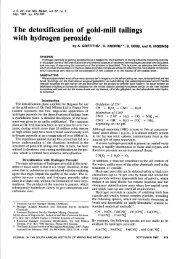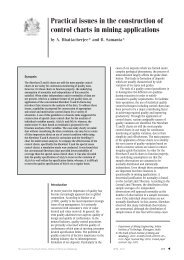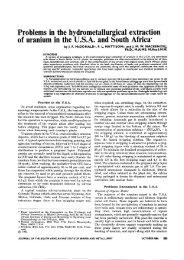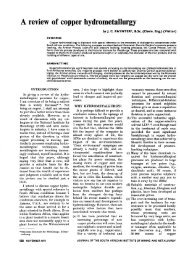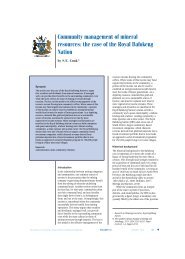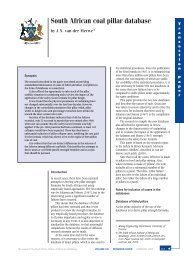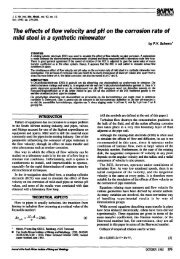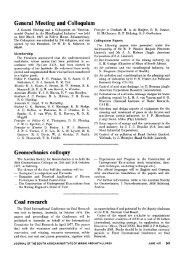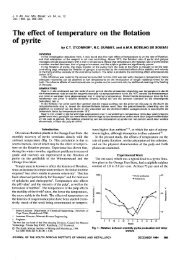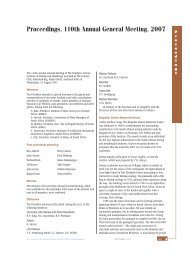Survey and geotechnical slope monitoring considerations - saimm
Survey and geotechnical slope monitoring considerations - saimm
Survey and geotechnical slope monitoring considerations - saimm
Create successful ePaper yourself
Turn your PDF publications into a flip-book with our unique Google optimized e-Paper software.
Synopsis<br />
<strong>Survey</strong> <strong>and</strong> <strong>geotechnical</strong> <strong>slope</strong><br />
<strong>monitoring</strong> <strong>considerations</strong><br />
by F.T. Cawood* <strong>and</strong> T.R. Stacey*<br />
Monitoring of the <strong>slope</strong>s of surface mines can prevent loss of life,<br />
loss of equipment, loss of production <strong>and</strong> possibly the loss of the<br />
mine. The effectiveness of such <strong>monitoring</strong> depends on the extent to<br />
which <strong>slope</strong>s give adequate advanced warning before failing, <strong>and</strong> on<br />
the ability of the <strong>monitoring</strong> system to detect such warning. In this<br />
paper an overview is given of <strong>slope</strong> <strong>monitoring</strong> requirements, from<br />
both the <strong>geotechnical</strong> <strong>and</strong> survey points of view, as well as the<br />
types of equipment <strong>and</strong> instrumentation that are available. Legal<br />
issues relevant to <strong>slope</strong> <strong>monitoring</strong> are also dealt with.<br />
It is concluded that conventional <strong>geotechnical</strong> <strong>and</strong> survey<br />
instrumentation will continue to have their place in <strong>slope</strong><br />
<strong>monitoring</strong>. However, the <strong>slope</strong> <strong>monitoring</strong> scene has changed<br />
substantially in recent years. Areal <strong>and</strong> volume-based <strong>monitoring</strong><br />
equipment is now available <strong>and</strong> this has provided, <strong>and</strong> will continue<br />
to provide, the means to improve safety, <strong>and</strong> to enhance productivity<br />
in mining. Its benefit to <strong>slope</strong> management is substantial. In<br />
the near future it is expected that data obtained from such<br />
equipment will add a much needed new dimension to <strong>slope</strong><br />
engineering, <strong>and</strong> be used to improve <strong>slope</strong> designs <strong>and</strong> to optimize<br />
<strong>slope</strong> angles.<br />
Introduction<br />
Monitoring of the <strong>slope</strong>s of surface mines can<br />
prevent loss of life, equipment, production <strong>and</strong><br />
possibly the loss of the mine. The effectiveness<br />
of such <strong>monitoring</strong> depends on the extent to<br />
which <strong>slope</strong>s give adequate advanced warning<br />
before failing, <strong>and</strong> on the ability of the<br />
<strong>monitoring</strong> system to detect such warning.<br />
There is considerable evidence (for example,<br />
Ding et al., 1998) to indicate that <strong>slope</strong>s do<br />
give ample warning, which means that it is<br />
well worth the effort to spend time on investigating<br />
<strong>and</strong> implementing appropriate<br />
<strong>monitoring</strong> systems. Figure 1 illustrates the<br />
value of survey <strong>monitoring</strong> at Venetia<br />
Diamond Mine, where the exponential<br />
movement at Prism M11-3 indicated on the<br />
survey charts gave advanced warning of<br />
ultimate failure. It is important to note,<br />
however, that in the hard rock open pits that<br />
are being mined nowadays, failures often<br />
occur after very small deformations. Such<br />
failures may be very localised <strong>and</strong>, unless such<br />
a localized area is being very closely <strong>and</strong><br />
accurately monitored, failure may occur<br />
apparently without warning. The dictates for<br />
such situations are therefore accurate, remote<br />
<strong>monitoring</strong>. This paper gives an overview of<br />
the survey <strong>and</strong> <strong>geotechnical</strong> <strong>considerations</strong> for<br />
effective <strong>monitoring</strong> systems as established<br />
from a literature survey, various case studies<br />
<strong>and</strong> observation.<br />
The <strong>monitoring</strong> process normally<br />
constitutes five steps. It starts with <strong>monitoring</strong><br />
requirements. This is to establish the<br />
objectives, need, advantages (expressed in<br />
both economic <strong>and</strong> health <strong>and</strong> safety terms),<br />
researching historic problems as case studies<br />
<strong>and</strong> finally preparing a report to decisionmakers<br />
motivating the need for <strong>monitoring</strong><br />
along with the expected benefits.<br />
The second step is to establish the project<br />
requirements, which follows from the pit<br />
design <strong>and</strong> a risk assessment. The outcome of<br />
this will state the probability of failure <strong>and</strong> the<br />
variables that will most likely contribute to<br />
such failure.<br />
The third step will take account of these<br />
variables in designing the <strong>monitoring</strong> system,<br />
investigating appropriate instrumentation <strong>and</strong><br />
implementing the <strong>monitoring</strong> system (Ding et<br />
al., 1998). An overview of these <strong>considerations</strong><br />
is the subject of this paper.<br />
The fourth step is the actual measurement<br />
<strong>and</strong> recording of field data. Issues to be dealt<br />
with, which will have been thoroughly<br />
considered during the design of the <strong>monitoring</strong><br />
system, are measuring techniques <strong>and</strong><br />
frequencies, accuracy, precision <strong>and</strong> personnel<br />
responsibilities.<br />
The fifth <strong>and</strong> final step is interpretation<br />
<strong>and</strong> reporting of <strong>monitoring</strong> data. This<br />
involves processing, analysis, interpretation<br />
* School of Mining Engineering, University of the<br />
Witwatersr<strong>and</strong>, Johannesburg, South Africa.<br />
© The South African Institute of Mining <strong>and</strong><br />
Metallurgy, 2006. SA ISSN 0038–223X/3.00 +<br />
0.00. Paper received Apr. 2006; revised paper<br />
received Jun. 2006.<br />
T<br />
r<br />
a<br />
n<br />
s<br />
a<br />
c<br />
t<br />
i<br />
o<br />
n<br />
P<br />
a<br />
p<br />
e<br />
r<br />
The Journal of The South African Institute of Mining <strong>and</strong> Metallurgy VOLUME 106 REFEREED PAPER JULY 2006<br />
495<br />
▲
<strong>Survey</strong> <strong>and</strong> <strong>geotechnical</strong> <strong>slope</strong> <strong>monitoring</strong> <strong>considerations</strong><br />
Figure 1—Advanced warning of <strong>slope</strong> failure through survey <strong>monitoring</strong> (Source: Venetia Mine)<br />
Table I<br />
Design process<br />
Step Description Design principle<br />
1 Statement of the problem (performance objectives) 1<br />
2 Functional requirements <strong>and</strong> constraints (design variable <strong>and</strong> design issues) 1<br />
3 Collection of information (site characterization, rock properties, groundwater, in situ stresses) 2<br />
4 Concept formulation (<strong>geotechnical</strong> model) 3<br />
5 Analysis of solution components (analytical, numerical, empirical, observational methods) 3, 4<br />
6 Synthesis <strong>and</strong> specifications for alternative solutions (shapes, sizes, locations, orientations of excavations) 3, 4<br />
7 Evaluation (performance assessment) 5<br />
8 Optimization (performance assessment) 5<br />
9 Recommendation 6<br />
10 Implementation (efficient excavation, <strong>and</strong> <strong>monitoring</strong>) 6<br />
<strong>and</strong> presentation of <strong>monitoring</strong> data. The reporting of results<br />
<strong>and</strong> documenting of events, decisions, design changes <strong>and</strong><br />
cost-benefit analysis complete the <strong>monitoring</strong> process.<br />
In the body of the paper below, <strong>geotechnical</strong> <strong>and</strong> survey<br />
<strong>considerations</strong> in <strong>slope</strong> <strong>monitoring</strong>, <strong>and</strong> design <strong>and</strong> legal<br />
compliance issues associated with them, are dealt with.<br />
Monitoring <strong>considerations</strong><br />
The main <strong>considerations</strong> for effective <strong>monitoring</strong> relate to<br />
correct design, legal compliance, <strong>monitoring</strong> requirements<br />
<strong>and</strong> system design providing for both <strong>geotechnical</strong> <strong>and</strong><br />
survey <strong>monitoring</strong> instrumentation. These <strong>considerations</strong> are<br />
individually discussed in this section.<br />
Design <strong>considerations</strong><br />
The design of rock <strong>slope</strong>s <strong>and</strong> <strong>slope</strong> <strong>monitoring</strong> systems<br />
should be a thorough process that takes into account<br />
adequate information <strong>and</strong> provides a design with an<br />
acceptable risk. This process could be based on the design<br />
principles developed by Bieniawski (1991, 1992), who<br />
defined a series of six principles that encompass a design<br />
process or methodology:<br />
1. Clarity of design objectives <strong>and</strong> functional<br />
requirements<br />
2. Minimum uncertainty of geological conditions<br />
3. Simplicity of design components<br />
4. State-of-the-art practice<br />
5. Optimization <strong>and</strong><br />
6. Constructability.<br />
If the design cannot be implemented safely <strong>and</strong> efficiently<br />
it does not satisfy these principles. It will be necessary to<br />
review the design <strong>and</strong> repeat, either partially or completely,<br />
the design methodology until the design is optimized. The<br />
design methodology corresponding with the above six design<br />
principles is summarized in the ten steps shown in the ‘circle<br />
or wheel of design’ (Stacey, 2006) in Figure 2 <strong>and</strong> in Table I.<br />
This methodology represents a thorough design process<br />
<strong>and</strong> can be used as a checklist to ensure that a defensible<br />
design has been carried out. It is also interesting to observe<br />
the similarity between this design process <strong>and</strong> the strategic<br />
planning process developed by Ilbury <strong>and</strong> Sunter (2005),<br />
confirming that design is a strategic issue (Stacey, 2006).<br />
Some segments of the engineering circle need to be<br />
▲<br />
496 JULY 2006 VOLUME 106 REFEREED PAPER The Journal of The South African Institute of Mining <strong>and</strong> Metallurgy
<strong>Survey</strong> <strong>and</strong> <strong>geotechnical</strong> <strong>slope</strong> <strong>monitoring</strong> <strong>considerations</strong><br />
Figure 2—The engineering circle or wheel of design<br />
emphasized. The problem statement ensures that all parties<br />
underst<strong>and</strong> what is being designed <strong>and</strong> the constraints on<br />
the design. The ‘defining the design’ part of the process is<br />
most important, <strong>and</strong> the formulation of the <strong>geotechnical</strong> or<br />
conceptual model is critical. The basis for this is a comprehensive<br />
site investigation (minimization of uncertainty), a<br />
significant aspect of which should be a thorough structural<br />
geological interpretation. This will assist in the identification<br />
of potential kinematic <strong>slope</strong> failure mechanisms for stability<br />
analysis, <strong>and</strong> will indicate the most sensitive areas for the<br />
design of a <strong>monitoring</strong> system. There is often a misconception<br />
that analysis is design, <strong>and</strong> many sophisticated<br />
analyses, with little underlying validity in terms of input data<br />
<strong>and</strong> failure criteria, are often carried out. It may be observed<br />
from Figure 2 that ‘design analyses’, which involve analytical<br />
(including numerical), empirical <strong>and</strong> observational methods,<br />
occupy only one step of the overall design methodology, <strong>and</strong><br />
this step is bridged by Bieniawski’s design principles 3 <strong>and</strong><br />
4. Analysis is only a tool to obtain answers to the problem<br />
that has been posed. If the input information is inadequate,<br />
<strong>and</strong> the concept or <strong>geotechnical</strong> model (including the<br />
interpretation of mechanisms of behaviour <strong>and</strong> choice of<br />
appropriate failure or design criteria) is incorrectly<br />
formulated, the answers obtained from the analysis may be<br />
scientifically correct, but will be wrong with regard to a valid<br />
design. It is the thorough underst<strong>and</strong>ing of the expected<br />
<strong>slope</strong> behaviour (Where will movements take place? What<br />
magnitudes of movements will occur? How rapidly will<br />
movements occur? etc.) that allows a satisfactory <strong>slope</strong><br />
<strong>monitoring</strong> system to be designed <strong>and</strong> implemented.<br />
Monitoring is an important aspect in the design process.<br />
One of the main aims of such <strong>monitoring</strong> should be to check<br />
whether the mechanism of behaviour of the designed<br />
structure or opening is as expected <strong>and</strong> whether the design<br />
criteria used were appropriate—in other words, to confirm the<br />
validity of the design. If the behaviour is not as expected<br />
then it will be necessary to loop back to an earlier step in the<br />
process <strong>and</strong> reassess the design. It may even be necessary to<br />
carry out a completely new design. The sooner that<br />
<strong>monitoring</strong> information or data can be obtained the better,<br />
since costly errors <strong>and</strong> consequences will then have the best<br />
chance of being avoided. The importance of review <strong>and</strong><br />
<strong>monitoring</strong> in any engineering design process is emphasized<br />
by the ‘spokes’ of the wheel in Figure 2. The implication is<br />
that the design must meet the stated objectives at all stages.<br />
The above discussion is relevant to the design of the<br />
<strong>slope</strong>s themselves as well as to the design of the <strong>slope</strong><br />
<strong>monitoring</strong> system. If the steps are followed diligently in the<br />
design of the <strong>slope</strong> <strong>monitoring</strong> system, a robust <strong>monitoring</strong><br />
system should result.<br />
Compliance <strong>considerations</strong><br />
Mine Health <strong>and</strong> Safety Act (MHSA)<br />
Before discussing the requirements of the South African<br />
MHSA insofar as they relate to <strong>monitoring</strong> surveys, the<br />
relevance of ISO 9000 accreditation should be emphasized.<br />
Such certification will in many ways go a long way towards<br />
complying with the MHSA because of the Quality Plan<br />
concept <strong>and</strong> its emphasis on leading practice. The objectives<br />
of the MHSA are to protect the health <strong>and</strong> safety of<br />
employees; to require employers <strong>and</strong> employees to identify<br />
hazards; to eliminate, control <strong>and</strong> minimize risks; <strong>and</strong> to<br />
provide for effective <strong>monitoring</strong> of health <strong>and</strong> safety<br />
conditions at mines. Section 2 of the MHSA goes further by<br />
stating that employers must equip mines with systems to<br />
ensure safe conditions <strong>and</strong> compile an annual report on<br />
health <strong>and</strong> safety, which report must be supported by<br />
appropriate statistics. Section 7 makes it obligatory that mine<br />
employers must appoint persons with appropriate qualifications<br />
<strong>and</strong> training to underst<strong>and</strong> the hazards associated<br />
with the work*. Section 10 of the MHSA states that it is the<br />
employer’s responsibility to ensure that such proper training<br />
programmes are accredited <strong>and</strong> put in place. Section 9 deals<br />
with Codes of Practice, which is discussed in the following<br />
sub-section. These requirements are emphasized in Section<br />
11, which section provides for the employer to:<br />
➤ Identify hazards <strong>and</strong> assess the risk<br />
➤ Record significant hazards identified in the risk<br />
assessment<br />
➤ Determine all measures to eliminate, control <strong>and</strong><br />
minimize the risk <strong>and</strong> in so far as the risk remains,<br />
institute a programme to monitor the risk;<strong>and</strong><br />
➤ Periodically review the hazards identified, risk<br />
assessment <strong>and</strong> control measures.<br />
Mine health <strong>and</strong> safety matters are not only the<br />
employer’s responsibility. The employee, according to<br />
*It is to facilitate such education <strong>and</strong> training that the School of Mining<br />
Engineering, University of the Witwatersr<strong>and</strong> introduced a course in Slope<br />
Stability Monitoring at postgraduate level<br />
T<br />
r<br />
a<br />
n<br />
s<br />
a<br />
c<br />
t<br />
i<br />
o<br />
n<br />
P<br />
a<br />
p<br />
e<br />
r<br />
The Journal of The South African Institute of Mining <strong>and</strong> Metallurgy VOLUME 106 REFEREED PAPER JULY 2006<br />
497<br />
▲
<strong>Survey</strong> <strong>and</strong> <strong>geotechnical</strong> <strong>slope</strong> <strong>monitoring</strong> <strong>considerations</strong><br />
Sections 22 <strong>and</strong> 23 of the MHSA, must firstly report any<br />
situation presenting a health <strong>and</strong> safety risk <strong>and</strong> has the<br />
right to leave unsafe areas. As far as offences <strong>and</strong> legal<br />
proceedings are concerned, negligence is defined as ‘Any<br />
person who, by a negligent act or by a negligent omission,<br />
causes serious injury or serious illness to a person at a<br />
mine…’. Apart from these obvious sections that relate to the<br />
<strong>monitoring</strong> of <strong>slope</strong>s at surface mines, there are separate<br />
regulations that deal with the appointment of competent<br />
persons <strong>and</strong> detailed provisions <strong>and</strong> requirements for, for<br />
example, mine surveying.<br />
Code of practice<br />
In accordance with the MHSA, an employer must implement<br />
a code of practice (COP) on any matter affecting the health<br />
<strong>and</strong> safety of employees <strong>and</strong> any other person who may be<br />
directly affected by the activities at the mine, if the Chief<br />
Inspector of Mines requires it, <strong>and</strong> the preparation of a COP is<br />
then m<strong>and</strong>atory. A guideline for the preparation of a COP to<br />
combat rock fall <strong>and</strong> <strong>slope</strong> instability related accidents in<br />
surface mines has been issued by the South African<br />
Department of Minerals <strong>and</strong> Energy (DME). The implementation<br />
of the COP is aimed at satisfying four principles<br />
(Gudmanz, 1998):<br />
➤<br />
➤<br />
➤<br />
Identification <strong>and</strong> documentation of rock related<br />
hazards<br />
Development of appropriate strategies to eliminate or<br />
reduce the risk caused by these hazards<br />
Allocation of responsibility/duties for the execution of<br />
these strategies<br />
➤ Training of persons to enable them to carry out their<br />
duties.<br />
The guideline for the preparation of the COP, which is<br />
available to download from the DME website<br />
(www.dme.gov.za), contains a considerable number of<br />
references to <strong>slope</strong> <strong>monitoring</strong>. For example, the following<br />
are some of the statements that appear in the guideline:<br />
‘The COP must set out a ……… description of the <strong>slope</strong><br />
management programme of failure on bench, stack <strong>and</strong><br />
overall <strong>slope</strong>s. Detailed strategies for an ongoing<br />
stability <strong>monitoring</strong> ……. programme ……’<br />
‘The COP must set out a description ….. of the<br />
measures to determine the stability of the mine<br />
covering at least the following:<br />
– <strong>monitoring</strong> of both the rock mass <strong>and</strong> major<br />
geological structures in the mine;<br />
– <strong>monitoring</strong> of potential planar failure, toppling<br />
<strong>and</strong> ravelling.’<br />
The content of Annex 1 to the guideline, which is for<br />
information purposes, is of direct relevance to <strong>slope</strong><br />
<strong>monitoring</strong>. The following are some of the statements that<br />
appear in this Annex:<br />
‘Success [of ground control measures] is measured by<br />
the level of awareness developed before any<br />
wall/bench failure <strong>and</strong> the level of the consequence of a<br />
wall/bench failure on the operations.’<br />
‘The inherent uncertainty associated with <strong>geotechnical</strong><br />
engineering means that it is necessary to regularly<br />
monitor the performance of the pit walls to verify the<br />
stability or otherwise of relevant areas in the mine.<br />
Monitoring of the pit walls therefore becomes an<br />
important tool for locating any potential failures of<br />
ground before the unstable rock mass becomes<br />
hazardous. Well-designed <strong>monitoring</strong> programs can<br />
help differentiate between normal elastic movements,<br />
inconsequential dilation <strong>and</strong> incipient pit wall failure.’<br />
‘Early detection of wall failure allows mine operators to<br />
plan <strong>and</strong> implement appropriate actions with sufficient<br />
notice such that the effect of the failure on mine safety<br />
<strong>and</strong> productivity is minimal. The specific nature of<br />
<strong>monitoring</strong> programs required for a given open pit<br />
would be dependent on the site-specific conditions of<br />
the mine. For example, stiffer rocks will tend to deflect<br />
less than softer rocks before failure <strong>and</strong> certain rock<br />
types or geological structures can be weakened by<br />
water, thus necessitating more frequent <strong>monitoring</strong><br />
after periods of rain.’<br />
‘If there is adequate <strong>monitoring</strong> <strong>and</strong> a good level of<br />
underst<strong>and</strong>ing of the ground conditions at each site,<br />
there should be no ‘unexpected’ failures. Slope failures<br />
do not occur spontaneously. There is scientific<br />
reasoning for each failure, <strong>and</strong> failures do not occur<br />
without warning if the failed area is being well<br />
monitored. Conversely, once unusual pit wall<br />
movements such as cracking have been observed, it<br />
does not necessarily follow that the wall will fail.’<br />
The implementation of a COP represents good<br />
engineering design practice. It has been shown (Stacey,<br />
2003) that there is significant overlap between the defined<br />
requirements for the drawing up of the COP <strong>and</strong> the rock<br />
engineering design process described above.<br />
Geotechnical <strong>considerations</strong><br />
The <strong>geotechnical</strong> aspects that must be addressed in designing<br />
a <strong>slope</strong> <strong>monitoring</strong> system derive directly from the design<br />
process. Only once the conceptual or <strong>geotechnical</strong> model of<br />
the <strong>slope</strong> has been developed can there be any underst<strong>and</strong>ing<br />
of how the <strong>slope</strong> will behave <strong>and</strong> therefore what <strong>monitoring</strong><br />
systems are appropriate. The differences in <strong>slope</strong> behaviour<br />
are well illustrated by case studies of <strong>monitoring</strong> at various<br />
mines (Zavodni, 2000; Ryan <strong>and</strong> Call, 1992; Stacey et al.,<br />
2003). The first step in underst<strong>and</strong>ing the <strong>geotechnical</strong><br />
conditions is the carrying out of a thorough investigation of<br />
the geological conditions. The extent of investigation will<br />
depend on the type of <strong>slope</strong> <strong>and</strong> its importance. For example,<br />
bench <strong>slope</strong>s are of much less consequence than ramp <strong>and</strong><br />
overall <strong>slope</strong>s <strong>and</strong> therefore will require less detailed<br />
information.<br />
Site investigation includes interpretation of remote<br />
sensing data <strong>and</strong> aerial photographs, mapping of rock<br />
exposures (both on surface <strong>and</strong> underground if there are any<br />
underground excavations), logging of borehole core, other<br />
borehole information, <strong>and</strong> geophysical investigation. The<br />
▲<br />
498 JULY 2006 VOLUME 106 REFEREED PAPER The Journal of The South African Institute of Mining <strong>and</strong> Metallurgy
<strong>Survey</strong> <strong>and</strong> <strong>geotechnical</strong> <strong>slope</strong> <strong>monitoring</strong> <strong>considerations</strong><br />
importance of a thorough structural geological analysis to<br />
identify the structural features that may influence the<br />
stability of <strong>slope</strong>s is emphasized. Rock samples will be<br />
selected for laboratory testing, <strong>and</strong> it may be necessary to<br />
carry out field scale testing. Many, very useful <strong>geotechnical</strong><br />
data can be obtained concurrently with geological<br />
exploration. Unfortunately, geological exploration <strong>and</strong><br />
<strong>geotechnical</strong> investigation are often treated as separate<br />
activities, with the result that <strong>geotechnical</strong> information that<br />
could be obtained during the exploration stage is often lost.<br />
Activities often have to be repeated to obtain the required<br />
information, <strong>and</strong> this is at considerable extra <strong>and</strong><br />
unnecessary cost. The data obtained from the site investigation<br />
<strong>and</strong> associated testing will provide information on the<br />
geological structure <strong>and</strong> hence rock mass structure, presence<br />
of major planes of weakness such as faults, groundwater<br />
conditions, rock material <strong>and</strong> rock mass strength <strong>and</strong><br />
deformability, etc. The better the information available, the<br />
better the rock engineering assessment <strong>and</strong> design that can<br />
be carried out. The documentation of this information to<br />
ensure its accessibility for any future requirements is<br />
extremely important, <strong>and</strong> the system described by Little<br />
(2006) represents an excellent example.<br />
The output from the <strong>geotechnical</strong> investigation <strong>and</strong> the<br />
<strong>slope</strong> design should answer the following questions about<br />
determining <strong>slope</strong> <strong>monitoring</strong> requirements:<br />
➤<br />
➤<br />
➤<br />
➤<br />
➤<br />
➤<br />
➤<br />
➤<br />
What types of movements are likely—translational,<br />
rotational, toppling, rock mass?<br />
What type of behaviour is likely—brittle <strong>and</strong> ‘sudden’,<br />
or yielding?<br />
What magnitudes of movement are to be expected?<br />
What rates of movement are likely?<br />
What are the groundwater conditions?<br />
Will the <strong>slope</strong> be influenced by dynamic loading—<br />
seismic <strong>and</strong> blasting?<br />
Will deterioration of the rocks take place significantly<br />
over time?<br />
Will <strong>slope</strong> geometry, particularly plan geometry, modify<br />
<strong>slope</strong> behaviour?<br />
This information will be used to answer questions such<br />
as the following about the appropriate type of <strong>monitoring</strong>:<br />
➤<br />
➤<br />
➤<br />
➤<br />
➤<br />
➤<br />
➤<br />
What should be monitored—movements, stresses,<br />
groundwater, seismicity, etc.?<br />
Will visual <strong>monitoring</strong> be adequate?<br />
Will point location <strong>monitoring</strong> such as crack meters,<br />
borehole instrumentation, inclinometers be effective?<br />
Will conventional survey techniques with targets<br />
provide the necessary information?<br />
Is a ‘volume’ <strong>monitoring</strong> method such as seismic<br />
<strong>monitoring</strong> necessary to determine initiation of failure<br />
in the rock mass?<br />
Is a surface <strong>monitoring</strong> system using laser or radar<br />
systems necessary?<br />
Will satellite <strong>monitoring</strong> be appropriate?<br />
➤<br />
➤<br />
➤<br />
Is real time <strong>monitoring</strong> necessary for safety purposes<br />
<strong>and</strong> if not required, at what frequencies should<br />
observations be made?<br />
How will the <strong>monitoring</strong> system be linked with <strong>slope</strong><br />
management?<br />
How will the <strong>slope</strong> <strong>monitoring</strong> system warn the<br />
employees of potential danger?<br />
It can be seen that the design of the <strong>monitoring</strong> system,<br />
including the choice of types of <strong>monitoring</strong> <strong>and</strong><br />
corresponding types of instruments or methods is almost<br />
entirely dependent on the <strong>slope</strong> <strong>geotechnical</strong> conditions.<br />
Geotechnical <strong>monitoring</strong> instrumentation<br />
Geotechnical instrumentation has been used for many years<br />
for the <strong>monitoring</strong> of <strong>slope</strong>s. It includes such common<br />
instruments as crack meters, various types of borehole <strong>and</strong><br />
surface extensometers, tilt meters, inclinometers, stress<br />
meters, <strong>and</strong> piezometers. This instrumentation has been, <strong>and</strong><br />
continues to be, widely used in civil engineering <strong>slope</strong>s. Such<br />
<strong>slope</strong>s must be designed to be stable in the long term <strong>and</strong><br />
<strong>slope</strong> <strong>monitoring</strong> is usually for public safety purposes, to<br />
confirm that stability is being maintained. In mining,<br />
however, <strong>slope</strong>s are often temporary <strong>and</strong> must, for economic<br />
reasons, be excavated closer to the stability limit.<br />
Geotechnical instrumentation, if installed, may therefore<br />
have a limited life before it is mined out. In addition, many<br />
instruments are damaged during the mining process.<br />
In the past few years new equipment has become<br />
available which is ideally suited to <strong>slope</strong> <strong>monitoring</strong> in a<br />
mining environment <strong>and</strong> also for critical natural <strong>slope</strong>s. Such<br />
equipment is seismic <strong>monitoring</strong> (Stacey et al., 2004), laser<br />
<strong>monitoring</strong> (Lichti et al., 2002; McIntosh <strong>and</strong> Krupnik,<br />
2002), radar <strong>monitoring</strong> (Anglo Coal <strong>and</strong> Reutech Radar<br />
System, 2005; Groundprobe, 2005) <strong>and</strong> satellite <strong>monitoring</strong><br />
(ASD-Network, 2006; Kaab, 2002). There is almost a<br />
complete overlap between <strong>geotechnical</strong> <strong>and</strong> survey<br />
capabilities with these types of equipment, <strong>and</strong> they are also<br />
dealt with briefly in the section on survey instrumentation<br />
below. From the <strong>geotechnical</strong> point of view, this new<br />
equipment represents a significant <strong>and</strong> exciting advance in<br />
the <strong>slope</strong> <strong>monitoring</strong> field. It monitors areas <strong>and</strong> volumes,<br />
not only points <strong>and</strong> can therefore pick up failure or<br />
movements wherever they occur—often instabilities develop<br />
between point <strong>monitoring</strong> locations. Perhaps its most<br />
powerful capability from a <strong>geotechnical</strong> point of view is its<br />
ability to monitor data almost in real time. This should allow<br />
mechanisms of behaviour, including the location of the<br />
initiation of failure, to be determined explicitly rather than to<br />
be inferred from point data, or after the event in a case of a<br />
<strong>slope</strong> failure. Such inferences may be completely incorrect<br />
<strong>and</strong> lead to incorrect conclusions or designs.<br />
The new equipment now available can provide answers to<br />
most of the questions posed above, <strong>and</strong> will also provide<br />
powerful tools for the confirmation of <strong>slope</strong> designs—the last<br />
step in the design process.<br />
<strong>Survey</strong> <strong>considerations</strong><br />
This section deals with survey <strong>monitoring</strong> <strong>considerations</strong> for<br />
T<br />
r<br />
a<br />
n<br />
s<br />
a<br />
c<br />
t<br />
i<br />
o<br />
n<br />
P<br />
a<br />
p<br />
e<br />
r<br />
The Journal of The South African Institute of Mining <strong>and</strong> Metallurgy VOLUME 106 REFEREED PAPER JULY 2006<br />
499<br />
▲
<strong>Survey</strong> <strong>and</strong> <strong>geotechnical</strong> <strong>slope</strong> <strong>monitoring</strong> <strong>considerations</strong><br />
systems design. It does not, however, discuss the survey<br />
fundamentals that govern all classes of surveying. These<br />
fundamentals are generic <strong>and</strong> apply to all classes of<br />
surveying. In the context of deformation surveys, these are<br />
limited to:<br />
➤<br />
➤<br />
➤<br />
<strong>Survey</strong> data that allow for numeric values stating<br />
location, size, shape <strong>and</strong> direction of planes <strong>and</strong> threedimensional<br />
surfaces (Burkholder, 2001)<br />
<strong>Survey</strong> measurements <strong>and</strong> data gathering methods that<br />
meet the design specifications<br />
Data processing <strong>and</strong> choice of coordinate system <strong>and</strong><br />
datum<br />
➤ Presentation of data in a manner that allows for<br />
timeous <strong>and</strong> accurate decision-making.<br />
From the onset it must be emphasized that data<br />
processing through sophisticated software cannot correct for<br />
poorly designed systems <strong>and</strong> that survey principles such as<br />
‘work from the whole to the part’ <strong>and</strong> ‘checking’ apply as<br />
always.<br />
<strong>Survey</strong> <strong>monitoring</strong> instrumentation<br />
The main issues to consider here are design specifications,<br />
equipment selection, implementation <strong>and</strong> installation. Design<br />
specifications are typically expected magnitudes of<br />
movement, parameters to measure, type <strong>and</strong> scale of<br />
deformation to be monitored, purposes of different<br />
instruments, locations of equipment <strong>and</strong> checks using<br />
different survey methods <strong>and</strong> equipment. During the<br />
planning phase, <strong>monitoring</strong> design specifications give an<br />
indication of the desired accuracy <strong>and</strong> precision required for<br />
meaningful analysis. The design specifications guide the<br />
<strong>monitoring</strong> specifications, i.e. definition of objectives <strong>and</strong><br />
contingency plans; decision on the type, number <strong>and</strong><br />
frequency of measurements; human resources <strong>and</strong> training<br />
requirements; <strong>and</strong> the planning of <strong>monitoring</strong>, processing<br />
<strong>and</strong> reporting methods. Geodetic survey instrument selection<br />
depends on economic value added as a result of the system,<br />
the required level of confidence in the results, how it will<br />
complement <strong>geotechnical</strong> instruments, ease of interface, GIS<br />
adaptability, survey budget for these instruments, environmental<br />
conditions in which equipment can operate <strong>and</strong><br />
survey training necessary for its optimal use. Examples of<br />
survey equipment suitable for deformation surveys are levels,<br />
theodolites, total stations ( Rueger et al., 1992), GPS<br />
(Jeffreys, 2004) <strong>and</strong> remote sensing methods (Kaab, 2002),<br />
which include photogrammetric, laser ( McIntosh <strong>and</strong><br />
Krupnik, 2002), satellite imaging (ASD-Network, 2006) <strong>and</strong><br />
radar surveys (Anglo Coal <strong>and</strong> Reutech Radar Systems,<br />
2005; GroundProbe, 2005). Once the equipment is selected<br />
implementation <strong>and</strong> installation commence. Implementation<br />
means procurement <strong>and</strong> installation of the instruments,<br />
calibration, deciding on maintenance schedules, establishing<br />
factors that will affect accuracy, along with propagation<br />
thereof, operating procedures, <strong>and</strong> protection against<br />
v<strong>and</strong>alism. A final instrumentation consideration is the<br />
versatility of the system. For example, when using laser<br />
scanning equipment in combination with software such as<br />
RealWorks (Smith, 2005), volume calculations between two<br />
scanned surfaces become possible. The recent advances in<br />
the development of both ground <strong>and</strong> satellite radar systems<br />
will continue to receive significant attention because of the<br />
technology’s versatility, coverage <strong>and</strong> millimetre precision.<br />
However, there are still concerns about accuracy, availability<br />
<strong>and</strong> interface with other survey measurement systems. These<br />
require further improvement <strong>and</strong> research.<br />
System design <strong>considerations</strong><br />
Installation of survey measuring equipment requires<br />
placement of prisms (for total stations) or receivers (for GPS)<br />
firstly on the object (the <strong>slope</strong>) to be monitored <strong>and</strong> secondly,<br />
one or more at fixed positions (around the object). In terms<br />
of consistency <strong>and</strong> uniformity of error propagation, all prisms<br />
(or reflectors) <strong>and</strong> receivers must be identical. Further installation<br />
issues to consider during system design are size <strong>and</strong><br />
weight of equipment, power supply network, protection of<br />
equipment <strong>and</strong> maintenance of the system. Setting-up the<br />
control centre for automatic collection <strong>and</strong> processing of<br />
<strong>monitoring</strong> data is the next consideration. Data transfer could<br />
be via radio, cable, cellular or internet communication, which<br />
technologies make it possible for all elements of the<br />
<strong>monitoring</strong> network to be accessed remotely from the mine.<br />
Other systems design <strong>considerations</strong> deal with warning<br />
signals, actions required <strong>and</strong> the communication thereof.<br />
Warning signals are normally generated automatically when<br />
relative position differences or the velocity of movement<br />
exceed the pre-set limits. Adjustments to measuring data (or<br />
error propagation methods) <strong>and</strong> mode of presentation are the<br />
final systems design issues to consider.<br />
Control network design <strong>considerations</strong><br />
These <strong>considerations</strong> are necessary in order to establish<br />
relative movement among monitored points. Correct design of<br />
the network is essential to establish such relative<br />
movements. Thomson (2005) found that a poorly designed<br />
<strong>and</strong> adjusted survey network has ‘significantly large<br />
orientation <strong>and</strong> free station residuals’. This problem is<br />
exacerbated when one or two control points are not available<br />
for orientation – i.e. despite the use of highly accurate subcentimetre<br />
<strong>and</strong> single second survey instruments. According<br />
to Thomson’s observations poor network design causes<br />
errors in the order of 20 seconds of arc <strong>and</strong> 30 mm over a<br />
distance of 800 m. It also significantly affects vertical angle<br />
measurement, which explains the height inaccuracies that are<br />
encountered during typical deformation surveys. Network<br />
design <strong>considerations</strong> include establishing the reference<br />
transfer beacons from the control beacons, which must<br />
include the mine’s survey benchmark. Transfer beacons are<br />
the reference beacons on which the measuring equipment is<br />
positioned for <strong>monitoring</strong> the prisms on the <strong>slope</strong>. Regardless<br />
of the method of surveying, a clear line of sight will be<br />
necessary between these beacons. It might seem to be<br />
unnecessary when <strong>monitoring</strong> is done by GPS, but the<br />
principle of checking will require a different method of<br />
surveying, which will require a line of sight free from any<br />
▲<br />
500 JULY 2006 VOLUME 106 REFEREED PAPER The Journal of The South African Institute of Mining <strong>and</strong> Metallurgy
<strong>Survey</strong> <strong>and</strong> <strong>geotechnical</strong> <strong>slope</strong> <strong>monitoring</strong> <strong>considerations</strong><br />
obstacles. Future construction projects, waste rock dumps<br />
<strong>and</strong> stockpile areas must be taken into account when doing<br />
the network design in order to ensure permanent open lines<br />
of sight. In mining, this information is available from the<br />
mine planning department.<br />
The next consideration is a clear line of sight between the<br />
transfer beacons <strong>and</strong> the <strong>monitoring</strong> points. Additional<br />
reference points must be built as part of the network design<br />
in case of damages, loss of line of sight <strong>and</strong> ground<br />
instability. Ground instability is a definite possibility when<br />
transfer beacons are situated near the crest, which is<br />
necessary for ensuring a clear line of sight to the <strong>monitoring</strong><br />
points. Stability must be checked periodically by taking<br />
frequent readings to one or more reference stations on stable<br />
ground away from the mine. These control points could be<br />
located anywhere from 100 m to 3 km away depending on<br />
the conditions. In addition, the transfer beacons must be<br />
resurveyed periodically to check their stability because it is<br />
often not clear if deformations are caused by movement of<br />
control points or the points being monitored. The <strong>monitoring</strong><br />
points are on the unstable <strong>slope</strong> in the form of either total<br />
station prisms or GPS receivers.<br />
Conclusions<br />
In this paper an overview has been given of <strong>slope</strong> <strong>monitoring</strong><br />
requirements, from both the <strong>geotechnical</strong> <strong>and</strong> survey points<br />
of view, as well as generically of the types of equipment <strong>and</strong><br />
instrumentation that are available. Legal issues relevant to<br />
<strong>slope</strong> <strong>monitoring</strong> have also been dealt with.<br />
It is concluded that conventional <strong>geotechnical</strong> instrumentation<br />
<strong>and</strong> survey will continue to have their place in <strong>slope</strong><br />
<strong>monitoring</strong>. However, the <strong>slope</strong> <strong>monitoring</strong> scene has<br />
changed substantially in recent years. Areal <strong>and</strong> volume<br />
based <strong>monitoring</strong> equipment is now available <strong>and</strong> this has<br />
provided, <strong>and</strong> will continue to provide, the means to improve<br />
safety, <strong>and</strong> to enhance productivity in mining. Its benefit to<br />
<strong>slope</strong> management is substantial. In the near future it is<br />
expected that data obtained from such equipment will add a<br />
much-needed new dimension to <strong>slope</strong> engineering, be used<br />
to improve <strong>slope</strong> designs <strong>and</strong> to optimize <strong>slope</strong> angles.<br />
References<br />
pp. 57–67.<br />
DING, X., MONTGOMERY, S.B., TSAKIRI, M., SWINDELLS, C.F., <strong>and</strong> JEWELL, R.J.<br />
Integrated <strong>monitoring</strong> systems for open pit wall deformation, MERIWA<br />
Project No. M236, MERIWA Report No. 186, June 1998.<br />
GROUNDPROBE BROCHURE on Slope Stability Radar, www.groundprobe.com.,<br />
2005.<br />
GUDMANZ, K.M. The implementation of codes of practice, Proc. Symp. Rock<br />
Mechanics <strong>and</strong> Productivity <strong>and</strong> The Implementation of Codes of Practice,<br />
1998, M.F. H<strong>and</strong>ley (ed.), S. Afr. National Group of Int. Soc. Rock Mech.,<br />
pp. 3–6.<br />
ILBURY, C. <strong>and</strong> SUNTER, C. Games foxes play—planning for extraordinary times,<br />
Human & Rosseau Tafelberg, 2005, 180 pp.<br />
JEFFREYS, S. The Role of GPS in an Open Pit Slope Stability Monitoring<br />
Programme. Project report for Slope Stability Monitoring Certificate,<br />
University of the Witwatersr<strong>and</strong>, Johannesburg, January 2004.<br />
KAAB, A. Monitoring high-mountain terrain deformation from repeated air- <strong>and</strong><br />
spaceborne optical data: Examples using digital aerial imagery <strong>and</strong> ASTER<br />
data. Journal of Photogrammetry <strong>and</strong> Remote Sensing, vol. 57, November<br />
2002, Elsevier Science, pp. 39–52.<br />
LICHTI, D.D., GORDON, S.J. et al., Ground-Based Laser Scanners: Operation,<br />
Systems <strong>and</strong> Applications. Geomatica, vol. 56, no. 1, 2002, pp. 21–33.<br />
LITTLE, M. The benefits to open pit rock <strong>slope</strong> design of comprehensive<br />
<strong>geotechnical</strong> databases, Proc. Int. Symp. on Stability of Rock Slopes in<br />
Mining <strong>and</strong> Civil Engineering Situations, Cape Town 2006, S. Afr. Inst.<br />
Min. Metall., pp 97–112.<br />
MCINTOSH, K. <strong>and</strong> KRUPNIK, A. Integration of Laser-derived DSMs <strong>and</strong> matched<br />
image edges for generating an accurate surface model. Journal of<br />
Photogrammetry <strong>and</strong> Remote Sensing, 56 of 2002, Elsevier Science,<br />
pp. 167–176.<br />
MANAKE, A. <strong>and</strong> KULKARNI, M.N. Study of the deformation of Koyna dam using<br />
the Global Positioning System. <strong>Survey</strong> Review, vol. 36, no. 285, July<br />
2002, pp. 497–507.<br />
RUEGER, J.M., ALANKO, G., <strong>and</strong> SNOW, T.J. Monitoring of an open cut mine with a<br />
surveying robot. The Australian <strong>Survey</strong>or, December 1994, pp. 252–266.<br />
RYAN, T.M. <strong>and</strong> CALL, R.D. Applications of rock mass <strong>monitoring</strong> for <strong>slope</strong><br />
stability assessment of pit <strong>slope</strong> failure, Proc. 33rd U S Symp. on Rock<br />
Mech., 1992, Tillerson <strong>and</strong> Wawersik (eds.), Balkema, pp. 221–229.<br />
SMITH, M. New features for <strong>Survey</strong> Software. Position IT, September/October<br />
2005, p. 18.<br />
STACEY, T.R. The link between the design process in rock engineering <strong>and</strong> the<br />
code of practice to combat rock fall <strong>and</strong> rockburst accidents, Jl S. Afr. Inst.<br />
Min. Metall., vol. 104, no. 1, 2003, pp. 29–33.<br />
T<br />
r<br />
a<br />
n<br />
s<br />
a<br />
c<br />
t<br />
i<br />
o<br />
n<br />
P<br />
a<br />
p<br />
e<br />
r<br />
ANGLO COAL AND REUTECH RADAR SYSTEMS Brochure on Movement <strong>and</strong><br />
<strong>Survey</strong>ing Radar—An Overview, January 2005. www.rrs.co.za<br />
ASD-NETWORK Radar Satellite Service checks stability of Africa’s largest<br />
artificial hole. Available from www.asd-network.com, accessed 10 January<br />
2006.<br />
BIENIAWSKI, Z.T. In search of a design methodology for rock mechanics, Rock<br />
Mechanics as a Multidisciplinary Science, Proc. 32nd U S Symp. on Rock<br />
Mech., 1991, Roegiers (ed.), Balkema, pp. 1027–1036.<br />
BIENIAWSKI, Z.T. Invited Paper: Principles of engineering design for rock<br />
mechanics, Rock Mechanics, Proc. 33rd U S Symp. on Rock Mech., 1992,<br />
Tillerson <strong>and</strong> Wawersik (eds.), Balkema, pp. 1031–1040.<br />
BURKHOLDER, E.F. Spatial Data, Coordinate Systems, <strong>and</strong> the Science of<br />
Measurement. Journal of <strong>Survey</strong>ing Engineering, November 2001,<br />
American Society of Civil Engineers, pp. 143–155.<br />
DING, X., REN, D et al.. Automatic <strong>monitoring</strong> of <strong>slope</strong> deformations using<br />
<strong>geotechnical</strong> instruments, Journal of <strong>Survey</strong>ing Engineering, May 2000.<br />
STACEY, T.R. Design—a strategic issue, Proc. 2nd Int. Seminar on Strategic vs<br />
Tactical Approaches in Mining, Perth, Australia, Australian Centre for<br />
Geomechanics, 2006, Section 4, 13p.<br />
STACEY, T.R., TERBRUGGE, P.J., KEYTER, G.J., <strong>and</strong> YU, XIANBIN. Extension strain – a<br />
new concept in open pit <strong>slope</strong> stability, <strong>and</strong> its use in the explanation of<br />
two <strong>slope</strong> failures, Proc. 5th Large Open Pit Conf., Kalgoorlie, Aus.I.M.M.,<br />
2003, pp. 259–266.<br />
STACEY, T.R., WESSELOO, J., <strong>and</strong> LYNCH, R. ‘Extension’ <strong>and</strong> seismicity in a hard<br />
rock open pit mine, Proc. 2nd Int. Seminar on Deep <strong>and</strong> High Stress<br />
Mining, South Africa, 2004, S. Afr. Inst. Min. Metall, pp. 41–53.<br />
THOMSON, C. The Importance of a good quality <strong>Survey</strong> Control Network in an<br />
Automated Slope Stability Monitoring Programme. Geosystems Africa<br />
Circular, 28 September 2005.<br />
ZAVODNI, Z.M. Time-dependent movements of open-pit <strong>slope</strong>s, Slope Stability<br />
in Surface Mining, Hustrulid, McCarter <strong>and</strong> Van Zyl (eds.), SME,<br />
Colorado, pp. 81–87. ◆<br />
The Journal of The South African Institute of Mining <strong>and</strong> Metallurgy VOLUME 106 REFEREED PAPER JULY 2006<br />
501<br />
▲
▲<br />
502 JULY 2006 VOLUME 106 REFEREED PAPER The Journal of The South African Institute of Mining <strong>and</strong> Metallurgy


